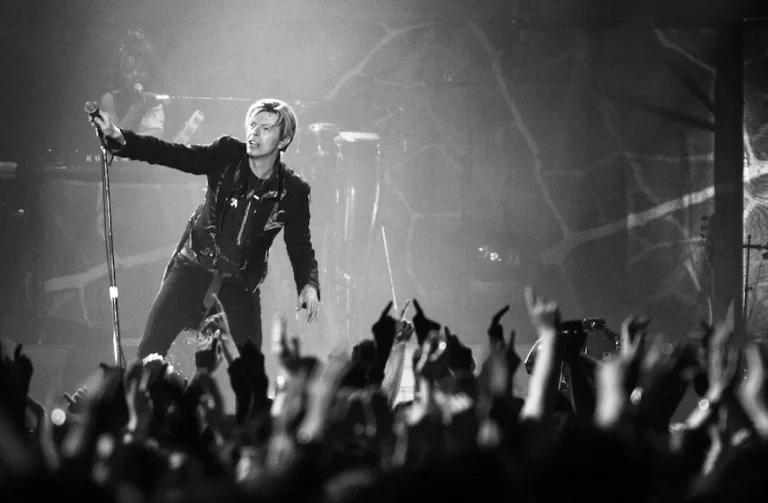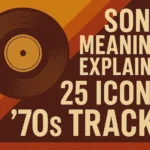The 1970s were a period of rapid motion for David Bowie. He opened the decade with bright, piano led art pop, stepped into glittering glam rock with full theatrical force, slid into polished American soul, then turned toward electronics, ambient textures and experiments with song structure. He used image, fashion and studio technique as active tools. This is the era that shaped the songs, looks and ideas most listeners associate with his name.
Across these years Bowie wrote characters, but he also wrote in a way that made everyday life feel cinematic. The records do not repeat each other. Each new release carries a fresh palette, a new haircut, a new band chemistry, a different way of using rhythm, and a new set of references. That constant change is the thread that ties the decade together.
Essential 1970s timeline
| Year | Album | Sound or persona | What to know |
|---|---|---|---|
| 1971 | Hunky Dory | Piano led art pop | “Life on Mars?” and a confident melodic voice |
| 1972 | The Rise and Fall of Ziggy Stardust and the Spiders from Mars | Glam rock, theatrical | Ziggy brings international attention |
| 1973 | Aladdin Sane | Harder glam with US tour energy | The lightning bolt era and sharper edges |
| 1974 | Diamond Dogs | Dystopian cabaret, proto punk | Arena staging collides with grit and sax driven grooves |
| 1975 | Young Americans | Polished soul and R&B | First major US radio embrace and crossover hits |
| 1976 | Station to Station | The Thin White Duke | Long grooves, cool precision, a pivot toward Berlin |
| 1977 | Low and “Heroes” | Electronic textures and instrumentals | New structures and tones that echo through pop |
| 1979 | Lodger | Restless art rock | Travel, rhythm experiments and sharp songwriting |
Personas
Ziggy Stardust: A glitter bright alien rock star landing on a troubled Earth. The look, androgyny and theatre pushed glam rock into mainstream rooms. The character runs across the 1972 to 1973 period, ending with a famous farewell on stage. The songs linked to Ziggy carry a sense of broadcast and prophecy that still draws new listeners.
The Thin White Duke: A pale figure in a waistcoat with slicked back hair around Station to Station. The music from this phase has cool surfaces and a strong pulse. The persona is discussed for its poise and for the way it framed a harder, more controlled stage show. Bowie later spoke about moving past the Duke, yet the record remains one of his most focused statements.
The Berlin Trilogy
The label Berlin Trilogy usually covers Low and “Heroes” from 1977 and Lodger from 1979. Bowie worked closely with Brian Eno and producer Tony Visconti, balancing concise songs with widescreen instrumentals, synths and unconventional structures. The sessions moved between locations, but Berlin’s atmosphere and the rooms at Hansa Studios shape the story people tell about this music.
On Low, the first side presents compact songs with clipped rhythms and bright synth lines, while the second side drifts into instrumentals that feel like city weather. “Heroes” keeps that split but adds a title track that towers over the decade, with layered microphones, urgent vocals and a guitar line that cuts like wire. Lodger closes the arc with travel images, unusual tunings and a restless approach to rhythm that points forward to the next phase of his career. When listeners search this topic they often ask which albums count, who played on them and what made the sound different from his earlier work.
Song meanings people ask about
“Heroes”
The song is tied to stories of a couple embracing near the Berlin Wall outside Hansa Studios. The lyric sets a small human moment against a loud, divided backdrop, then turns that moment into a pledge. The production rises in steps, as if the singer is pushing his voice through the air around him. That build, and the image of two people standing together, explain why searches often focus on the origin and the location.
“Life on Mars?”
Here Bowie sketches a girl disappointed by ordinary life who wanders into the bright distraction of film and pop culture. The lyric moves like a collage, yet the piano anchors it and the melody lifts the fragments into something vivid. People often ask about the title’s question mark and the song’s relationship to an earlier tune that later became “My Way.” The short version is that frustration turned into a new idea, and the new idea shines.
“Starman”
Inside the Ziggy narrative the Starman is a messenger who transmits hope through radio. The verses are domestic and specific, the chorus opens into sky, and the guitar hook plants itself in memory. Searches usually point to the Top of the Pops performance, the meaning of the “picked on you” line and the way the single helped the Ziggy era reach homes beyond the concert hall.
Tour timeline 1972 to 1978
- Ziggy Stardust Tour (1972 to 1973): compact and fierce, with the Spiders from Mars locking into a tight attack and a visual style that made headlines.
- Diamond Dogs Tour (1974): moving sets, noir lighting and theatrical scenes scaled up for arenas, matching the album’s dystopian streets and carnival touches.
- Isolar Tour (1976): stripped staging that fits the long grooves and cool surfaces of Station to Station, with a set that moves between earlier hits and the new material.
- Isolar II or Low and “Heroes” World Tour (1978): the Berlin sound travels worldwide, later captured on the live album Stage, with arrangements that highlight the rhythm section and synth textures.
Key collaborators
- Mick Ronson guitar and string arrangements in the Ziggy era
- Trevor Bolder bass and Mick Woodmansey drums for the Spiders from Mars
- Ken Scott and Tony Visconti in the producer’s chair during pivotal runs
- Carlos Alomar, George Murray, Dennis Davis as a mid decade rhythm team with tight interplay
- Brian Eno systems, processing and ideas that fed into the Berlin period
- Robert Fripp and Adrian Belew as standout guitar voices on key tracks
- Iggy Pop collaborator around The Idiot and Lust for Life in 1977
Starter listening
- Songs: “Starman”, “Heroes”, “Young Americans”
- One album front to back: Hunky Dory
FAQs
When did David Bowie die and of what
He died on 10 January 2016 in New York City after a private battle with liver cancer.
What albums are in the Berlin Trilogy
Low from 1977, “Heroes” from 1977 and Lodger from 1979.
Why did Bowie retire Ziggy
He felt boxed in by the character and ended it in 1973 to keep moving artistically.
Who was Bowie married to, and do people search for his family
Yes. He married Iman in 1992. Children Duncan Jones and Alexandria “Lexi” Jones are frequent topics.














